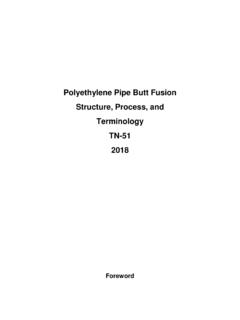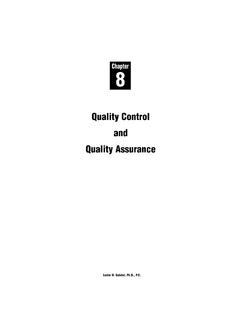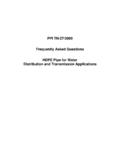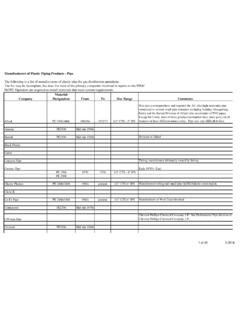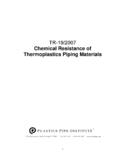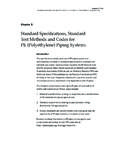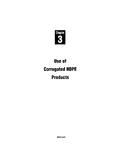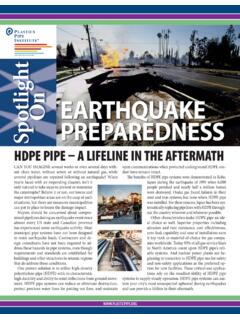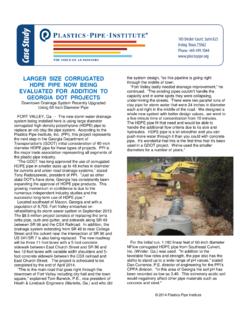Transcription of Guidance for Field Hydrostatic Testing Of High Density ...
1 Guidance for Field Hydrostatic Testing Of High Density Polyethylene Pressure Pipelines: Owner s Considerations, Planning, Procedures, and Checklists TN-46/2013a 105 Decker Court, Suite 825, Irving, TX 75062 P: 469-499-1044 F: 469-499-1063 Foreword This technical note was developed and published with the technical help and financial support of the members of the Plastics Pipe Institute. The members have shown their interest in quality products by assisting independent standard-making and user organizations in the development of standards, and also by developing reports on an industry-wide basis to help engineers, code officials, specifying groups, and users. This technical note has been prepared to provide those responsible for the maintenance of existing HDPE pipelines with suggested general guidelines for the repair of those lines that have been subjected to third party or other unforeseen damage.
2 These guidelines constitute a set of basic operations that have been demonstrated by test and experience to produce satisfactory repairs with commercially available materials. Each specific procedure must be acceptable to, and qualified by, the operator having legal responsibility for the performance of the piping system. This document was not intended to provide system design information. Go to the PPI website at for different system design documents. The Plastics Pipe Institute, Inc. has prepared this technical note as a service to the industry. The information in this report is offered in good faith and believed to be accurate at the time of its preparation, but is offered as is without any express or implied warranty, including WARRANTIES OF MERCHANTABILITY AND FITNESS FOR A PARTICULAR PURPOSE. Additional information may be needed in some areas, especially with regard to unusual or special applications.
3 Consult the manufacturer or material supplier for more detailed information. A list of member manufacturers is available from PPI. PPI does not endorse the proprietary products or processes of any manufacturer, and assumes no responsibility for compliance with applicable laws and regulations. PPI intends to revise this report from time to time, in response to comments and suggestions from users of this note. Please send suggestions for improvements to PPI. Information on other publications can be obtained by contacting PPI directly or visiting the web site. The Plastics Pipe Institute, Inc. 469-499-1044 June 2013 105 Decker Court, Suite 825, Irving, TX 75062 P: 469-499-1044 F: 469-499-1063 Guidance FOR Field Hydrostatic Testing OF HIGH Density POLYETHYLENE PRESSURE PIPELINES : OWNER S CONSIDERATIONS, PLANNING, PROCEDURES, AND CHECKLISTS Purpose of Field Testing : Hydrostatic Testing is universally known and accepted as the primary means of demonstrating the fitness for service of a pressurized component.
4 It is the responsibility of the owner, through its agents (engineer, contractor, or hydro-test company) to develop its own safe and appropriate hydro-test plan, taking into consideration all the elements presented in this and other reference documents, in order to access and accept the installed pipeline from the contractor. After hydrotest, a pipeline or pressure vessel component may usually be expected to safely contain its intended operating pressure. However, even after a successful hydro-test, leakage or forced ruptures may occur later, for a variety of other reasons. The pre-commissioning hydro-test is simply one tool for evaluating a pipeline . The purposes of Hydrostatic Field Testing of polyethylene pressure pipes using water are several, including: To access the installed structural integrity of the pipeline for acceptability. To try to reveal the occurrence of faults or defects in the pipe laying procedures, as exemplified by damaged pipe or fusion joints non-conforming to the qualified fusion procedures.
5 To try to reveal the occurrence of faults in the assembly procedures for pipeline components, as exemplified by tapping bands or saddles, flange sets, or Mechanical Joint assemblies. To try to validate that the pipeline will sustain an acceptable level of over- pressure slightly greater than its design pressure, without leakage. Note: Field Testing is not intended to supplement or replace product standard test requirements. The factors which affect the hydro- Testing of HDPE pipe during commissioning procedures are: the creep characteristics of the PE pipe, the percentage volume of trapped air in the pipeline , and temperature variations. The self-limiting creep expansion of HDPE pipe is normal behavior for plastic materials when an internal pressure is applied, and is not an indication of a leak. History: Polyethylene pipe is a lower modulus visco-elastic material that dilates in diameter (creep-strains) when subjected to higher stress during hydrotest.
6 This means that for a fixed volume of clean fill water, the Hydrostatic pressure will decline slightly during the test time, as the polyethylene molecular chains stretch and align under high stress. This pressure decline does not mean the polyethylene is leaking. It is a visco-elastic material parameter that requires adjustments to the Hydrostatic test procedure as compared to rigid elastic metallic pipes. This effect is more noticeable in larger diameter HDPE pipes, due to the large mass of clean fill water. Alternately, to hold constant pressure, an additional volume of make-up water will be required to fill the expanded volume of the stretched pipe diameter. Neither of the above two observations means that a leak is present in the pipeline . There are two test methods which can be used, depending upon the objectives of the test program. The easiest and quickest method suitable for all pipe diameters is the Modified Rebound Method originally developed by Lars-Eric Janson in the 1980 s.
7 As a similar alternate, ASTM F2164 instructs to fill and then thermally stabilize the pipeline with no air entrapment, pressurize the pipeline at test pressure for 4-hours, slightly reduce the pressure, and then observe the pressure for one hour to remain essentially constant (within 5% variation) to achieve an acceptable test. The Plastic Pipe Institute s Handbook of Polyethylene Pipe describes general Hydrostatic Testing , based on ASTM F2164. ( ) The concept behind hydro- Testing is to strain the pipe, fittings and appurtenances. Any defects from manufacturing or flaws from construction are typically forced by stress intensification to reveal themselves by weeping, leaking, or rupture. Any remaining defects are considered sub-critical within a tolerable flaw size limit, and should remain stable thereafter at the lower operating pressures. Hydro- Testing provides the normal level of assurance for leak integrity and the absence of flaws that exceed an intolerable flaw size.
8 Generally speaking, the higher is the ratio of test pressure to actual operating pressure, the more effective is the test, within material stress limits. Field Hydro- Testing of Polyethylene Piping and Pipelines: Hydrostatic pressure Testing requires adopting an appropriate combination of method, pressure, time duration and length of test section. The test parameters and test details usually are determined with due consideration for the following: Pipe material Pipe diameter and working pressure rating Length of test section Duration of the test Magnitude of the test pressure and planned rate of pressurization Presence of air in the pipeline Potential movement of pipeline thrust restraints Limiting pressure for thrust and anchor supports Accuracy of test equipment Ambient temperature changes during Testing (stability of the temperature) Presence of small leaks in hydrotest equipment or connections used Potential for leaks in the pipeline Note: It is advisable to begin Testing early during the pipeline installation to confirm adequacy of the fusion, laying, embedment procedures, and then later to progressively increase the length of test section, as experience is gained.
9 Polyethylene pipe lengths as long as 1000 meters, or 3000 feet, have been commonly tested. Definitions: (Refer to Appendix B) Selection of Test Pressure: The pipeline operator or owner is responsible for approving the type of test, the length of test, and the test parameters, as recommended by qualified advisors to the owner/operator. The Hydrostatic pressure test is a leak test intended to validate the integrity of the pipeline . The test pressure is never less than the designed operating pressure. The maximum Hydrostatic test pressure is based on the pipeline component with the lowest design pressure rating. The Hydrostatic test pressure is usually between times the nominal operating pressure and times the Design Pressure Rating of this component. The maximum Hydrostatic test pressure must be recorded at the lowest point along the pipeline , and must be compensated for temperatures other than 73 F.
10 The ASME Code for Pressure Pipe, in , requires the hydro-test at times the MAOP (maximum allowable operating pressure) for steel pipe. Typically, for ductile, visco-elastic HDPE pipe, the hoop-stress during hydro-test should exceed 30% of the specified minimum yield stress (SMYS) but remain less than 42% of the SYMS. The following test pressure ratios for HDPE pipe may be used, as decided by the pipeline owner, depending upon the owner s needs and test objectives. x Operating or Design Pressure x Operating or Design Pressure x Operating or Design Pressure For example: Design Pressure Rating for PE4710 (1000-psi pipe hoop-stress) x Design Pressure Rating fro PE4710 (1250-psi pipe hoop-stress) x Design Pressure Rating for PE4710 (1500-psi pipe hoop-stress) The Hydrostatic test pressure is a short-term test. The short-term tests for polyethylene pipe use the short-term strength (eg: stress intensity) of HDPE.
